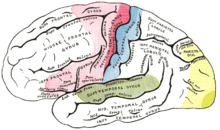Cortical blindness
| Classification according to ICD-10 | |
|---|---|
| H47.6 | Affections of the visual cortex |
| ICD-10 online (WHO version 2019) | |

Cortical blindness is an older neurological term for blindness due to a partial or complete failure of the primary visual cortex , i.e. the cortical area V1. More common today are the more specific names for partial failures, hemianopsia , quadrant anopia and scotoma (see anopia ). Since the primary visual cortex is organized retinotopically , the failures are expressed in the absence of conscious perception in circumscribed areas of the visual field . Since the visual fields of the left and right eye project onto the same side of the brain, the failures are homonymous. H. are the same for the left and right eye.
Cortical blindness is to be differentiated from mental blindness (the visual agnosia ), which is also based on lesions of the cortex , but on damage to higher visual areas if the primary visual cortex is intact. If there is a residual function of visual information processing in parts of the field of vision, one speaks of blind vision . The affected persons have no conscious visual impressions in these visual field areas, since the intactness of the primary visual cortex is obviously a prerequisite for this. Nevertheless, they can react sensibly to presented visual stimuli and, for example, indicate their location or name their color. A dissociative identity disorder , which can cause symptoms of cortical blindness, including the associated visual evoked potentials , must also be differentiated .
Individual evidence
- ↑ B. Waldvogel, A. Ullrich, H. Strasburger: Blind and seeing in one person: conclusions on the psychoneurobiology of seeing . In: The neurologist . tape 78 , no. November 11 , 2007, ISSN 0028-2804 , p. 1303-1309 , doi : 10.1007 / s00115-007-2309-x ( springer.com [accessed January 9, 2020]).
